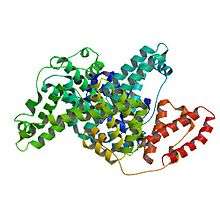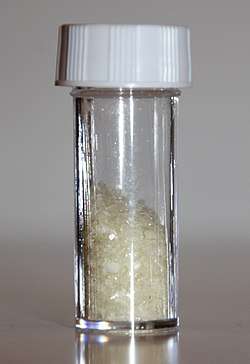Bovine serum albumin
Bovine serum albumin (BSA or "Fraction V") is a serum albumin protein derived from cows. It is often used as a protein concentration standard in lab experiments.
| albumin | |||||||
|---|---|---|---|---|---|---|---|
 | |||||||
| Identifiers | |||||||
| Organism | |||||||
| Symbol | ALB | ||||||
| Entrez | 280717 | ||||||
| HomoloGene | 105925 | ||||||
| RefSeq (mRNA) | NM_180992 | ||||||
| RefSeq (Prot) | NP_851335 | ||||||
| UniProt | P02769 | ||||||
| Other data | |||||||
| Chromosome | 6: 91.54 - 91.57 Mb | ||||||
| |||||||
The nickname "Fraction V" refers to albumin being the fifth fraction of the original Edwin Cohn purification methodology that made use of differential solubility characteristics of plasma proteins. By manipulating solvent concentrations, pH, salt levels, and temperature, Cohn was able to pull out successive "fractions" of blood plasma. The process was first commercialized with human albumin for medical use and later adopted for production of BSA.

Properties
The full-length BSA precursor protein is 607 amino acids (AAs) in length. An N-terminal 18-residue signal peptide is cut off from the precursor protein upon secretion, hence the initial protein product contains 589 amino acid residues. An additional six amino acids are cleaved to yield the mature BSA protein that contains 583 amino acids.[1]
| Peptide | Position | Length (AAs) | MW Da |
|---|---|---|---|
| Full length precursor | 1 – 607 | 607 | 69,324 |
| Signal peptide | 1 – 18 | 18 | 2,107 |
| Propeptide | 19 – 24 | 6 | 478 |
| Mature protein | 25 – 607 | 583 | 66,463 |
Physical properties of BSA:
- Number of amino acid residues: 583
- Molecular weight: 66,463 Da (= 66.5 kDa)
- isoelectric point in water at 25 °C: 4.7[2]
- Extinction coefficient of 43,824 M−1cm−1 at 279 nm[3]
- Dimensions: 140 × 40 × 40 Å (prolate ellipsoid where a = b < c)[4]
- pH of 1% Solution: 5.2-7 [5][6]
- Optical Rotation: [α]259: -61°; [α]264: -63°[5][6]
- Stokes Radius (rs): 3.48 nm[7]
- Sedimentation constant, S20,W × 1013: 4.5 (monomer), 6.7 (dimer)[5][6]
- Diffusion constant, D20,W × 10−7 cm2/s: 5.9[5][6]
- Partial specific volume, V20: 0.733[5][6]
- Intrinsic viscosity, η: 0.0413[5][6]
- Frictional ratio, f/f0: 1.30[5][6]
- Refractive index increment (578 nm) × 10−3: 1.90[5][6]
- Optical absorbance, A279 nm1 g/L: 0.667[5][6]
- Mean residue rotation, [m']233: 8443[5][6]
- Mean residue ellipticity: 21.1 [θ]209 nm; 20.1 [θ]222 nm[5][6]
- Estimated a-helix, %: 54[5][6]
- Estimated b-form, %: 18[5][6]
Applications
BSA has numerous biochemical applications including ELISAs (Enzyme-Linked Immunosorbent Assay), immunoblots, and immunohistochemistry. Because BSA is a small, stable, moderately non-reactive protein, it is often used as a blocker in immunohistochemistry.[8] During immunohistochemistry, which is the process that uses antibodies to identify antigens in cells, tissue sections are often incubated with BSA blockers to bind nonspecific binding sites.[9][10] This binding of BSA to nonspecific binding sites increases the chance that the antibodies will bind only to the antigens of interest.[11] The BSA blocker improves sensitivity by decreasing background noise as the sites are covered with the moderately non-reactive protein.[12][13] During this process, minimization of nonspecific binding of antibodies is essential in order to acquire the highest signal to noise ratio.[12] BSA is also used as a nutrient in cell and microbial culture. In restriction digests, BSA is used to stabilize some enzymes during the digestion of DNA and to prevent adhesion of the enzyme to reaction tubes, pipette tips, and other vessels.[14] This protein does not affect other enzymes that do not need it for stabilization. BSA is also commonly used to determine the quantity of other proteins, by comparing an unknown quantity of protein to known amounts of BSA (see Bradford protein assay). BSA is used because of its ability to increase signal in assays, its lack of effect in many biochemical reactions, and its low cost, since large quantities of it can be readily purified from bovine blood, a byproduct of the cattle industry. Another use for BSA is that it can be used to temporarily isolate substances that are blocking the activity of the enzyme that is needed, thus impeding polymerase chain reaction (PCR).[15] BSA has been widely used as a template to synthesize nanostructures.[16]
BSA is also the main constituent of fetal bovine serum, a common cell culture medium.
See also
- Acceptable daily intake
- Protein allergy
- Human serum albumin
- Serum albumin
References
- Majorek KA, Porebski PJ, Dayal A, Zimmerman MD, Jablonska K, Stewart AJ, Chruszcz M, Minor W (October 2012). "Structural and immunologic characterization of bovine, horse, and rabbit serum albumins". Molecular Immunology. 52 (3–4): 174–82. doi:10.1016/j.molimm.2012.05.011. PMC 3401331. PMID 22677715.
- Ge S, Kojio K, Takahara A, Kajiyama T (1998). "Bovine serum albumin adsorption onto immobilized organotrichlorosilane surface: influence of the phase separation on protein adsorption patterns". Journal of Biomaterials Science, Polymer Edition. 9 (2): 131–50. doi:10.1163/156856298x00479. PMID 9493841.
- Peters T (1975). Putman FW (ed.). The Plasma Proteins. Academic Press. pp. 133–181.
- Wright AK, Thompson MR (Feb 1975). "Hydrodynamic structure of bovine serum albumin determined by transient electric birefringence". Biophysical Journal. 15 (2 Pt 1): 137–41. doi:10.1016/S0006-3495(75)85797-3. PMC 1334600. PMID 1167468.
- Putnam FW (1975). The Plasma Proteins: Structure, Function and Genetic Control. 1 (2nd ed.). New York: Academic Press. pp. 141, 147. ASIN B007ESU1JQ.
- "Albumin from bovine serum" (PDF). Sigma-Aldrich. Retrieved 5 July 2013.
- Axelsson I (May 1978). "Characterization of proteins and other macromolecules by agarose gel chromatography". Journal of Chromatography A. 152 (1): 21–32. doi:10.1016/S0021-9673(00)85330-3.
- "Serum Albumins and Allergies". Structural Biology Knowledgebase. National Institute of General Medical Sciences of the National Institutes of Health. October 2013.
- "What Is Immunohistochemistry (IHC)". Immunohistochemistry. Sino Biological Inc.
- Farwell AP, Dubord-Tomasetti SA (September 1999). "Thyroid hormone regulates the expression of laminin in the developing rat cerebellum". Endocrinology. 140 (9): 4221–7. doi:10.1210/en.140.9.4221. PMID 10465295.
- "Tips for Reducing ELISA Background". Biocompare. Compare Networks. October 8, 2012.
- Ouellet, Michel (December 24, 2006). "How Blocking Works in Immunocytochemical Analysis with Serum or BSA". MadSci Network: Biochemistry. MadSci Network.
- "Blocker™ BSA (10X) in PBS". Thermo Fisher Scientific. Thermo Fisher Scientific Inc. Archived from the original on 2017-03-30.
- "BSA FAQ". Invitrogen. Archived from the original on 2011-12-28. Retrieved 19 January 2012.
- Kreader CA (March 1996). "Relief of amplification inhibition in PCR with bovine serum albumin or T4 gene 32 protein". Applied and Environmental Microbiology. 62 (3): 1102–6. PMC 167874. PMID 8975603.
- Rahmani T, Hajian A, Afkhami A, Bagheri H (2018). "A novel and high performance enzyme-less sensing layer for electrochemical detection of methyl parathion based on BSA templated Au–Ag bimetallic nanoclusters". New Journal of Chemistry. 42 (9): 7213–22. doi:10.1039/C8NJ00425K.
Further reading
- Hirayama K, Akashi S, Furuya M, Fukuhara K (Dec 1990). "Rapid confirmation and revision of the primary structure of bovine serum albumin by ESIMS and Frit-FAB LC/MS". Biochemical and Biophysical Research Communications. 173 (2): 639–46. doi:10.1016/S0006-291X(05)80083-X. PMID 2260975.
- Zhang M, Desai T, Ferrari M (May 1998). "Proteins and cells on PEG immobilized silicon surfaces" (PDF). Biomaterials. 19 (10): 953–60. doi:10.1016/S0142-9612(98)00026-X. PMID 9690837.
- Wise SA, Watters RL (2010-06-30). "Bovine Serum Albumin (7 % Solution)" (pdf). Certificate of Analysis. United States National Institute of Standards & Technology. Retrieved 2011-12-22.
External links
- Serum+Albumin,+Bovine at the US National Library of Medicine Medical Subject Headings (MeSH)